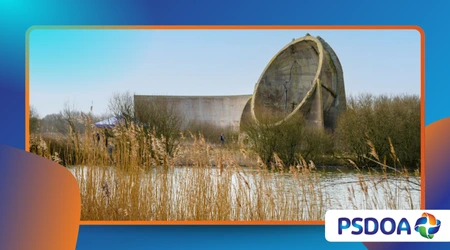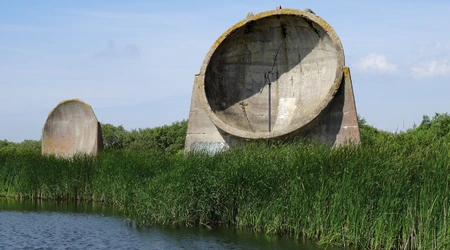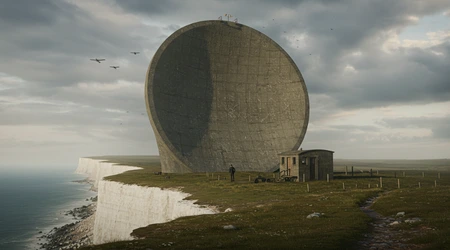Forgotten Sound Mirrors: Britain’s Early Warning System Before Radar

Forgotten sound mirrors stand as haunting relics of a pre-radar era, whispering tales of ingenuity born from necessity.
Anúncios
Before radar revolutionized air defense, Britain relied on these concrete giants to detect enemy aircraft.
Nestled along the coasts of Kent, Yorkshire, and beyond, these acoustic marvels captured sound waves from approaching planes, offering an early warning system in the face of looming aerial threats.
In the early 20th century, with air warfare emerging as a new frontier, these structures were cutting-edge, a testament to human creativity under pressure.
This article dives into the history, mechanics, and legacy of forgotten sound mirrors, exploring why they matter today and what their obsolescence teaches us about innovation.
Anúncios
The story of forgotten sound mirrors is not just about technology but about a nation grappling with the fear of invasion. In the 1920s and 1930s, Britain faced the rise of air power, with no reliable way to detect aircraft from afar.
These concrete dishes, some towering up to 30 feet, were a bold experiment in acoustic engineering. They amplified the hum of distant engines, allowing operators to pinpoint threats.
Why do these relics still captivate us? Perhaps because they remind us of a time when human ears, aided by concrete, stood as the first line of defense. Let’s uncover their rise, fall, and enduring significance.
The Birth of an Acoustic Defense
In the shadow of World War I, Britain faced a new kind of warfare: air raids. Zeppelins and early bombers exposed the nation’s vulnerability. By the 1920s, military minds sought a solution.
Enter the forgotten sound mirrors, designed to capture engine noise from miles away.
These parabolic concrete structures, often built along the south and east coasts, were an audacious attempt to harness sound for defense. Operators used stethoscope-like devices to listen, calculating an aircraft’s direction and distance.
The first sound mirror appeared in 1915 at Binbury Manor, Kent. By the late 1920s, larger, more sophisticated designs emerged, like the 200-foot wall at Denge.
These structures could detect aircraft up to 20 miles away under ideal conditions. According to Historic England, around 20 forgotten sound mirrors were built across Britain, with surviving examples still standing at Denge and Abbot’s Cliff.
++ The Fax Machine That Preceded the Telephone by 30 Years
Their construction was a race against time, driven by fears of German air raids.
Yet, the mirrors were not just engineering feats; they were symbols of resilience. Imagine operators huddled in wooden huts, ears pressed to tubes, listening for the faint drone of danger.
This was a world before digital precision, where human skill and concrete ingenuity held the line. The mirrors’ parabolic shape focused sound waves, much like a satellite dish captures signals today an analogy that bridges past and present.
Their design was simple yet brilliant, a testament to early 20th-century problem-solving.

How Sound Mirrors Worked
The mechanics of forgotten sound mirrors were elegantly straightforward. Shaped like curved dishes or walls, they reflected sound waves to a focal point.
A microphone or human listener at this point could hear amplified engine noise from distant aircraft.
Operators, often working in pairs, used trigonometry to estimate an aircraft’s position. The mirrors ranged from 20-foot dishes to massive 200-foot walls, each optimized for different ranges.
Wind and background noise were constant challenges. A gusty day could render the mirrors useless, as could the chatter of birds or waves. In calm conditions, though, they were remarkably effective.
For example, the Denge mirrors could pick up aircraft 15-20 miles away, giving defenders precious minutes to scramble fighters.
Also read: Pneumatic Tubes: How Cities Almost Ran on Air Power
This was no small feat in an era without radar’s precision. The mirrors’ limitations, however, foreshadowed their obsolescence.
Consider the operator’s role: part scientist, part sentinel. They trained to distinguish engine hums from natural sounds, a skill akin to a musician tuning an instrument.
This human element made the system both fragile and fascinating. The mirrors didn’t just amplify sound; they amplified human ingenuity, turning concrete into a shield against the skies.
Their story is a reminder that even “failed” technologies shape the path to progress.
The Rise and Fall of Sound Mirrors
The 1930s marked the peak of forgotten sound mirrors. Sites like Denge, with their cluster of three distinct mirrors, became icons of Britain’s air defense. Yet, their reign was short-lived.
By the mid-1930s, radar emerged, using radio waves to detect aircraft with far greater accuracy. Radar could see through fog, rain, and darkness conditions that silenced the mirrors. By 1939, the forgotten sound mirrors were largely abandoned.
Their decline wasn’t just technological; it was inevitable. Aircraft grew faster, flying at speeds that outpaced the mirrors’ detection range.
Read more: The Ice Houses of Ancient Persia: Natural Refrigeration Without Electricity
A 1935 test showed mirrors struggling to track planes traveling over 200 mph. Radar, by contrast, could detect targets hundreds of miles away.
The mirrors, once heralded as revolutionary, became relics overnight. Their concrete forms were left to weather the elements, a silent tribute to a fleeting era.
Still, their fall wasn’t failure. They bridged a gap when Britain needed it most, buying time until radar matured.
The mirrors’ story is like a vinyl record in the age of streaming outdated but cherished for its role in history. They remind us that innovation often builds on the shoulders of “forgotten” ideas, each step paving the way for the next.
Cultural and Historical Significance
Today, forgotten sound mirrors are more than relics; they’re cultural touchstones. Preserved sites like Denge attract historians, tourists, and artists.
Their eerie, monolithic forms inspire photographers and filmmakers, evoking a blend of nostalgia and mystery.
In 2025, these structures remain potent symbols of a world on the brink of war, standing as warnings of vulnerability in an uncertain age.
Their significance extends beyond history. They spark conversations about resilience and adaptation. For instance, local communities in Kent have rallied to restore the Denge mirrors, turning them into educational sites.
In 2023, a heritage project raised £50,000 to preserve these structures, highlighting their enduring appeal. The mirrors also inspire modern acoustic research, with scientists studying their design for applications like noise reduction.
Think of the mirrors as forgotten lighthouses, guiding us through the fog of history. They remind us that even obsolete technologies can teach us about creativity and survival.
Their preservation is a call to honor the past while embracing the future, ensuring these concrete giants continue to echo their story.
Sound Mirrors in a Modern Context

Could forgotten sound mirrors inspire today’s innovators? Their acoustic principles are finding new life in fields like urban planning and environmental monitoring.
For example, parabolic microphones, inspired by the mirrors’ design, are used to track wildlife or monitor industrial noise.
In 2025, researchers at the University of Southampton are exploring how these principles can improve sound-based sensors for smart cities.
The mirrors also offer lessons in sustainable design. Built from durable concrete, they’ve withstood decades of neglect. Compare this to modern tech, often obsolete within years.
Their longevity challenges us to create lasting solutions in an era of disposable gadgets. The mirrors’ story asks: what can we learn from simplicity in a world obsessed with complexity?
Moreover, they highlight the human element in technology. Unlike radar’s automated precision, the mirrors relied on skilled operators. This balance of human and machine is relevant today, as we navigate AI’s role in defense and beyond.
The forgotten sound mirrors urge us to value human ingenuity alongside technological leaps, a lesson as vital now as it was a century ago.
Table: Key Sound Mirror Sites in Britain
| Location | Year Built | Type | Status |
|---|---|---|---|
| Denge, Kent | 1928-1930 | 20ft, 30ft, 200ft | Preserved |
| Abbot’s Cliff, Kent | 1928 | 30ft dish | Partially Preserved |
| Kilnsea, Yorkshire | 1916 | 15ft dish | Preserved |
| Selsey, Sussex | 1930 | 20ft dish | Derelict |
The Future of Forgotten Sound Mirrors
As we look to 2025 and beyond, what lies ahead for forgotten sound mirrors? Preservation efforts are gaining momentum, with sites like Denge now protected as scheduled monuments.
Community groups and heritage organizations are pushing for their inclusion in educational curricula, ensuring future generations understand their role. In Kent, guided tours of the mirrors draw thousands annually, blending history with public engagement.
Their aesthetic allure also fuels creative projects. Artists are transforming mirrors into sound installations, using their acoustics to create immersive experiences.
For instance, a 2024 art festival at Denge featured soundscapes that mimicked wartime aircraft, bringing history to life. These efforts show how relics can inspire modern creativity, turning forgotten technology into cultural treasures.
The mirrors’ legacy is a call to action. They remind us to preserve not just structures but the stories they hold.
By studying forgotten sound mirrors, we learn to balance innovation with heritage, ensuring that the past continues to inform the future. Their concrete curves still listen, waiting for us to hear their lessons.
FAQs
What were sound mirrors used for?
They detected enemy aircraft by amplifying engine noise, serving as Britain’s early warning system before radar.
Why were sound mirrors abandoned?
Radar, introduced in the 1930s, offered superior range and reliability, rendering sound mirrors obsolete.
Can you visit sound mirrors today?
Yes, sites like Denge in Kent offer guided tours, showcasing their historical and architectural significance.
Are sound mirrors still relevant?
Their acoustic principles inspire modern applications in sound monitoring, and their preservation fuels cultural and educational projects.
In conclusion, forgotten sound mirrors are more than relics; they’re a bridge between past and present.
They embody a time when concrete and human ears stood against the skies, a poignant reminder of ingenuity under pressure. Their story challenges us to honor history while embracing innovation.
As we preserve these silent sentinels, we ensure their echoes resonate, teaching us resilience, creativity, and the enduring value of ideas that time forgot.
